


Published in the ASHRAE Transactions: Research, Volume 100, Part 1, paper #3744, American Society of Heating Refrigeration and Air-Conditioning Engineers, Atlanta, GA, 1994.
Development of Moisture Storage Coatings
for Enthalpy Storage Wallboard
Armin F. Rudd
Abstract
A research effort was conducted toward the development of moisture storage coatings which could be applied to thermal storage wallboard to achieve enthalpy storage (thermal and moisture energy storage) in buildings. The long-term goal being the development of building integrated thermal and moisture storage which could allow air conditioner load shifting for electric utility demand-side management. Two moisture storage coating mixtures, developed and tested between late 1990 and early 1991, could provide a low cost, building integrated, method of managing indoor humidity in hot-humid climates. Approximate loading curves for the moisture storage mixtures, the base materials alone, and regular gypsum wallboard, were experimentally determined in an environmental chamber using digital balances to monitor weight change as a function of relative humidity. Since there are large surface areas of interior gypsum wallboard in nearly all new houses, the effort centered around coatings which could be applied to those surfaces. Silica gel desiccant was mixed with base materials of flat latex paint and vinyl joint compound. Preliminary results showed that although both base materials reduced the desiccant utilization somewhat, relative to the silica gel manufacturer's isotherm, the coatings have potential for moisture storage applications. Between 40% RH and 60% RH, desiccant utilization ranged from 0.45 to 0.87 for the flat latex paint/grade 11 silica gel mixture (FLP/GR11), and from 0.23 to 0.46 for the vinyl joint compound/grade 40 silica gel mixture (VJC/GR40). Both moisture storage coating mixtures showed excellent storage capacity compared to the base materials alone, and compared to gypsum wallboard. Between 40% and 60% RH, the FLP/GR11 mixture had 10 times the change in moisture content as the paint alone, and 29 times that of gypsum wallboard. The VJC/GR40 mixture had 28 times the change in moisture content as the joint compound alone and 16 times that of gypsum wallboard. The moisture storage coatings were success fully applied to wallboard surfaces to create both fine and coarse textured finishes and were resistant to abrasion under normal handling. Other determinations of acceptability need to be made. Calculations showed that if the moisture storage coatings were applied to the walls and ceilings of a house in Miami, FL, there could be enough moisture storage (26.6 kg or 58.7 lb), between the equilibrium relative humidities of 40% and 60%, to eliminate the on-peak latent air conditioning load (13.6 kg or 30 lb). The heat of adsorption, as well as the normal sensible cooling load, would have to be eliminated by thermal storage in order to shift air conditioner use from peak to off-peak periods.
Background and Purpose
In many parts of the country, electric power utilities are finding that they cannot meet the summer peak electrical demand of their customers. Florida utilities in particular are faced with high growth rates; nearly every new house has central air-conditioning. For the largest power utility in Florida, the average peak-summer-day demand profile has nearly the same shape as the demand profile of a house's air conditioner for the same time period. Figure 1 shows the utility load shape (Taylor 1990) and the measured average load profile of 58 residential central air-conditioners (Paxon et al. 1980) in percent of load. If it was possible to shift some of the peak air-conditioning demand to off-peak hours there could be a tremendous savings in capital costs of electric generating equipment. The utility's savings could eventually translate into lower costs for customers.
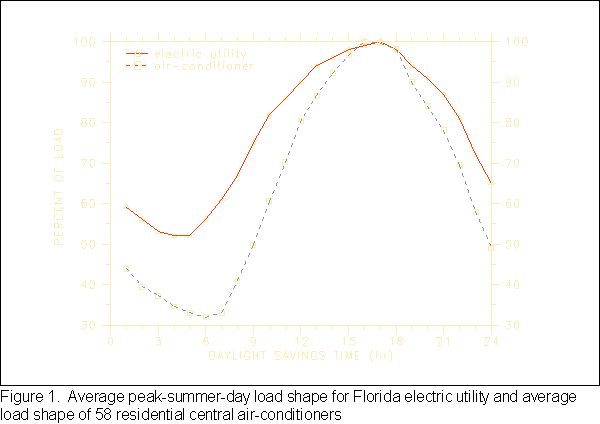
Thermal storage concepts for off-peak cooling in residential buildings have received considerable research but have rarely been put to use. The economies of scale, demand charges, and time-of-day rates have made ice storage systems popular for load shifting in commercial buildings, but ice storage has generally not been cost effective for residences. The equally important concept of moisture storage in buildings is only beginning to gain prominence in the research community. What may be needed is a low cost way to integrate both thermal and moisture energy storage into the building itself (Fairey 1984). Work by Shapiro et al. (1987) and Salyer et al. (1989) identified phase-change material (PCM) wallboard as a method to achieve thermal storage in buildings. Side-by-side room calorimeter tests by were conducted with full-size sheets of PCM wallboard and showed that small-scale differential scanning calorimeter results could adequately predict results obtained from full-scale testing (Rudd 1993). PCM wallboard may have the potential to shift most of electric utilities' peak load coming from residential air-conditioners to off-peak hours (Neeper 1990). However, in hot-humid climates thermal storage alone will not provide comfort when implementing air-conditioning load-shifting (Kamel et al. 1991). Thermal storage can keep the room temperature lower, but, with the same absolute amount of moisture in the air, a lower room temperature will make the room relative humidity higher. Since environmental comfort is a function of both temperature and humidity (ASHRAE 1989), both thermal and moisture storage must be utilized.
Building integrated thermal and moisture storage could also make conditions more favorable for the use of advanced solar cooling and heating technologies. One such solar cooling technology has been under research and development for several years (Swami et al. 1989). Figure 2 shows the basic operating modes of the DESiccant enhanced RADiant cooling (DESRAD) concept.
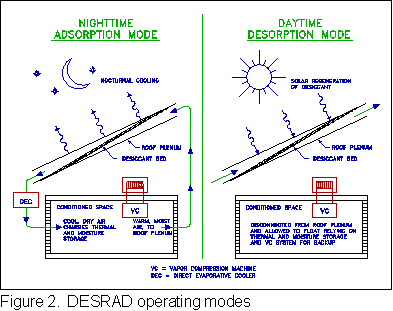
For the adsorption mode, excess moisture and heat, stored by the house during the day, is rejected at night to a desiccant bed and the cooler night sky. The desorption mode begins the next day when the sun's heat is used to regenerate the desiccant bed. The cycle repeats itself every 24 hours, using electrical energy only for fans and an evaporative cooler pump. The system relies on solar regeneration heat, nocturnal cooling, and thermal and moisture energy storage for its operation. PCM wallboard could be used to provide thermal energy storage while moisture storage could be provided by moisture storage coatings, yielding a composite thermal and moisture or enthalpy storage wallboard.
This paper describes a preliminary research effort toward the
development of moisture storage coatings which could be applied
to thermal storage wallboard to achieve enthalpy storage (thermal
and moisture storage) in buildings. As moisture is adsorbed in
the outer desiccant layer, the PCM layer will provide a sink for
the heat of adsorption; as moisture is later desorbed from the
outer desiccant layer, the wallboard will be cooled, removing
energy from the PCM so that it may be heated again in the next
cycle. This could work well with off-peak cooling since heat and
moisture are simultaneously entering the building during on-peak
periods, and heat and moisture are simultaneously being removed
from the building during off-peak cooling periods. It should be
clear that moisture storage alone will not allow air conditioner
load shifting. As moisture is sorbed, the heat of sorption must
be captured by thermal energy storage in addition to the normal
sensible cooling load for any load shifting to be possible.
Test Description
Two moisture storage coatings were developed and tested in an environmental chamber between late 1990 and early 1991. One coating consisted of grade 11 silica gel desiccant (GR11) mixed with flat latex paint (FLP) as the base material. The other coating was made from grade 40 silica gel (GR40) mixed with vinyl joint compound (VJC) as the base material. Approximate loading curves for the two moisture storage coatings, and the base materials alone, and gypsum wallboard (GWB) were experimentally determined. The tests were conducted in an environmental chamber. Digital balances were used to monitor the weight change of the samples as a function of relative humidity (RH). The manufacturer of the balances specifies reproducibility at 0.01 g. Table 1 describes the samples that were tested.
Descriptions of samples weighed on digital balances
| Sample | Description of Samples |
| VJC | Aluminum sheet coated on both sides with vinyl joint compound |
| VJC/GR40 | Aluminum sheet coated on both sides with a mixture of vinyl joint compound and grade 40 silica gel desiccant |
| FLP | Aluminum sheet coated on both sides with several layers of flat latex paint |
| FLP/GR11 | Aluminum sheet coated on both sides with a mixture of flat latex paint and grade 11 silica gel |
| GWB | Regular gypsum wallboard; sealed from moisture on the back and edges |
Equilibrium moisture loading curves were measured at 26.7oC (80oF). The environmental chamber was controlled within ±1% RH. At each of the fifteen equilibrium points, the chamber conditions were held constant until all sample weights were stable within ±0.5 grams or ±0.4%, whichever was less. All measurements were made every 15 seconds and averaged over 6 minute data-logging intervals.
Results
Dry weight was approximated for each sample by curve-fitting the equilibrium sample weights as a function of relative humidity and extrapolating to 0% relative humidity. The moisture content of each sample could then be calculated at each equilibrium point. This data was plotted versus relative humidity. The maximum moisture content, Umax, was determined from these plots by extrapolating to 100% relative humidity.
Figures 3, 4, 5 and 6 show preliminary results for experimentally determined loading curves. Moisture loading curves for the base materials, FLP and VJC, are shown in Figure 3. Figure 4 shows the manufacturer's isotherms for grade 11 (GR11) and grade 40 (GR40) silica gel (Davison). Figure 5 gives the loading curves for the two moisture storage coating mixtures -- FLP/GR11 and VJC/GR40. Figure 6 shows the loading curve for gypsum wallboard.
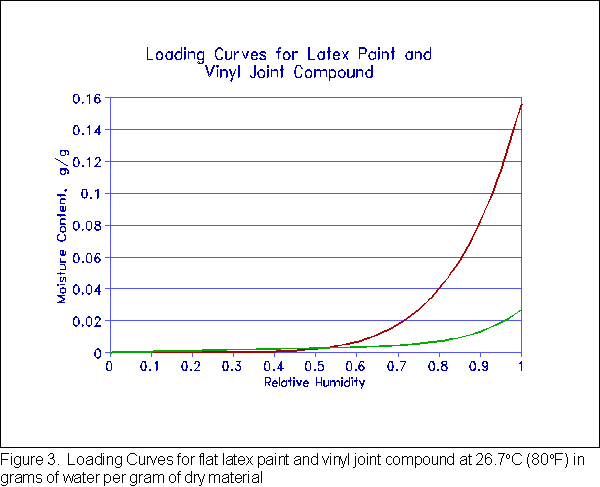
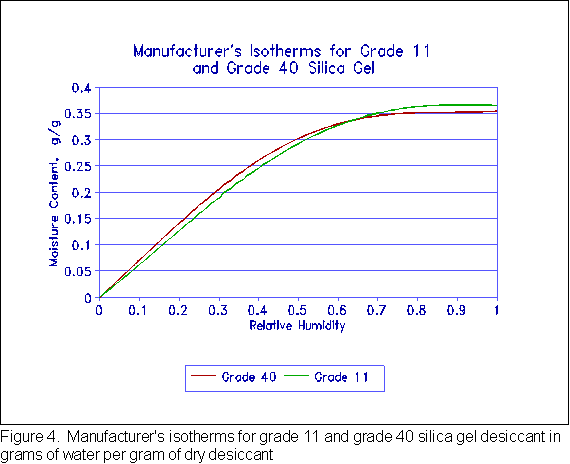
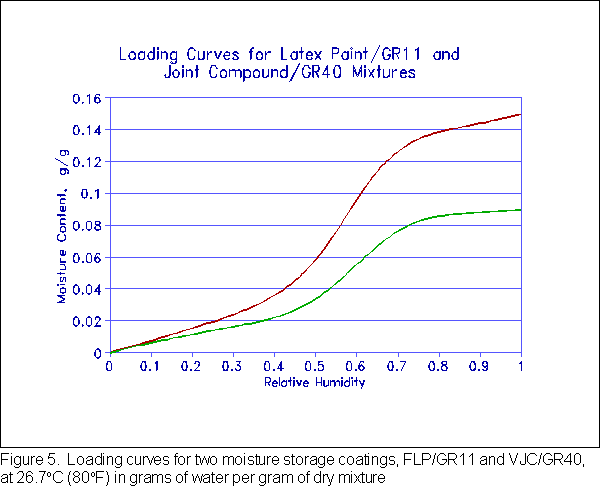
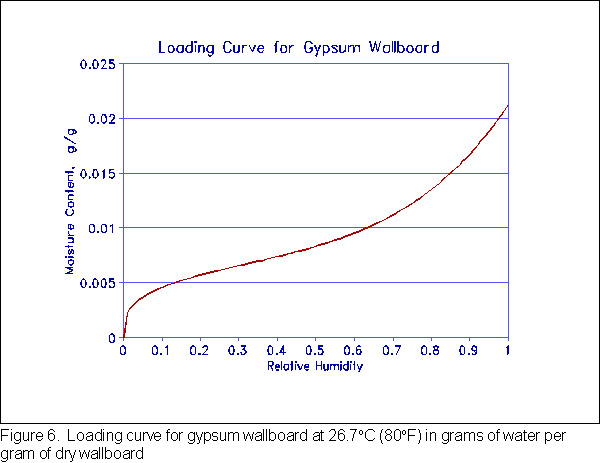
Brunauer (1945) published a classification of five types of adsorption isotherms. According to Gregg et al. (1982), most isotherms resulting from physical adsorption may be grouped into one of the Brunauer types. In order to get a simple label for the difference in the loading curve shapes, the samples tested in the environmental chamber were identified as one of the five Brunauer types, by visual inspection only. Both the paint and the joint compound alone have a type III shape. When these materials are mixed with silica gel, which is a type II desiccant, the resulting mixtures have a type IV shape. The type IV shape is good for moisture storage applications where a sharp positive slope is required in the middle RH ranges, as in building applications. Gypsum wallboard has a Type II shape.
Ideally, in order to verify all of the results, the entire test procedure would have been repeated several times with several identical samples. However, the single test method took near ly four months to complete and more environmental chamber time was not available. Since the results presented here are from only one test, they should be taken in the context of preliminary research. Also, these results do not provide information concerning the measured shape of partial loading curves when materials are cycled back and forth through intermediate humidities. That information would be quite useful when making application to real building situations and should be considered in future work.
A fundamental question that arises from mixing base materials with desiccant is: How much does the base material limit the moisture capacity of the desiccant? To determine this, the following analysis was performed:
(1)
where:-
Mbase = mass of base material, FLP or VJC
Mdes = mass of desiccant, GR11 or GR40
Mmix = mass of mixture, FLP/GR11 or VJC/GR40
| Udes= | (Umix*Mmix-Ubase*Mbase) |
|
|
|
| Mdes |
-
U<sub>base</sub> = moisture content of base material,
g <sub>water</sub>/g<sub>base</sub>
U<sub>des</sub> = moisture content of desiccant, g<sub>water</sub>/g<sub>des</sub>
U<sub>mix</sub> = moisture content of mixture, g<sub>water</sub>/g<sub>mix</sub>
Comparison of moisture content values for
FLP/GR11 mixture, and individual components
|
|
|||||
| RH | FLP/GR11 MIXTURE |
PAINT | UDES | MANUF. UGR11 |
UTILIZATION FACTOR |
| 0.40 | 0.0359 | 0.0006 | 0.111 | 0.245 | 0.451 |
| 0.42 | 0.0392 | 0.0008 | 0.121 | 0.256 | 0.473 |
| 0.44 | 0.0431 | 0.0010 | 0.132 | 0.265 | 0.499 |
| 0.46 | 0.0475 | 0.0013 | 0.145 | 0.275 | 0.530 |
| 0.48 | 0.0526 | 0.0017 | 0.160 | 0.283 | 0.566 |
| 0.50 | 0.0584 | 0.0022 | 0.178 | 0.292 | 0.608 |
| 0.52 | 0.0649 | 0.0028 | 0.197 | 0.300 | 0.656 |
| 0.54 | 0.0722 | 0.0036 | 0.218 | 0.307 | 0.709 |
| 0.56 | 0.0800 | 0.0045 | 0.240 | 0.314 | 0.765 |
| 0.58 | 0.0880 | 0.0056 | 0.263 | 0.321 | 0.820 |
| 0.60 | 0.0960 | 0.0068 | 0.285 | 0.327 | 0.873 |
Comparison of moisture content values for
VJC/GR40 mixture, and individual components
|
|
|||||
| RH | VJC/GR40 MIXTURE |
VJC | UDES | MANUF. UGR40 |
UTILIZATION FACTOR |
| 0.40 | 0.0219 | 0.0022 | 0.059 | 0.260 | 0.226 |
| 0.42 | 0.0235 | 0.0023 | 0.063 | 0.269 | 0.235 |
| 0.44 | 0.0255 | 0.0024 | 0.069 | 0.278 | 0.246 |
| 0.46 | 0.0277 | 0.0025 | 0.075 | 0.287 | 0.261 |
| 0.48 | 0.0305 | 0.0026 | 0.082 | 0.294 | 0.280 |
| 0.50 | 0.0336 | 0.0027 | 0.091 | 0.302 | 0.303 |
| 0.52 | 0.0373 | 0.0029 | 0.102 | 0.308 | 0.330 |
| 0.54 | 0.0414 | 0.0030 | 0.113 | 0.314 | 0.360 |
| 0.56 | 0.0458 | 0.0031 | 0.126 | 0.320 | 0.393 |
| 0.58 | 0.0505 | 0.0032 | 0.139 | 0.325 | 0.427 |
| 0.60 | 0.0553 | 0.0034 | 0.152 | 0.330 | 0.462 |
The range of relative humidity between 40% and 60% covers the range normally found in conditioned living spaces where the desiccant coatings may be useful for moisture storage. In that range, the moisture capacity of the paint and joint compound alone, and the regular gypsum wallboard, was negligible. However, the moisture capacities of the desiccant mixtures were large enough to warrant further study.
A comparison of Tables 2 and 3 shows that both of the base materials reduce the desiccant utilization somewhat. Latex paint reduces the desiccant utilization less than vinyl joint compound. Between 40% RH and 60% RH, desiccant utilization for the FLP/GR11 mixture ranged from 0.45 to 0.87. As relative humidity reached 65%, the paint reduced the desiccant utilization by less than 2%. Desiccant utilization for the VJC/GR40 mixture ranged from 0.23 to 0.46 between 40% RH and 60% RH.
Both moisture storage coatings showed excellent moisture capacity compared to the base material alone. As shown in Table 4, between 40% and 60% RH, the FLP/GR11 mixture had 10 times the change in moisture content as the paint alone, and 29 times that of gypsum wallboard. The VJC/GR40 mixture had 28 times the change in moisture content as the joint compound alone and 16 times that of gypsum wallboard.
Change in moisture content for test samples
between 40% and 60% relative humidity
| Moisture Content (g/g) | Change in Moist. Content |
||
| 40% RH | 60% RH | (g/g) | |
| Vinyl Joint Compound (VJC) | 0.0022 | 0.0034 | 0.0012 |
| Flat Latex Paint (FLP) | 0.0006 | 0.0068 | 0.0062 |
| Grade 40 Silica Gel (GR40) | 0.2600 | 0.3300 | 0.0700 |
| Grade 11 Silica Gel (GR11) | 0.2450 | 0.3270 | 0.0820 |
| VJC/GR40 mixture | 0.0219 | 0.0553 | 0.0334 |
| FLP/GR11 mixture | 0.0359 | 0.0960 | 0.0601 |
| Gypsum Wallboard | 0.0074 | 0.0095 | 0.0021 |
The moisture storage coatings were successfully applied to wallboard surfaces to create both fine and coarse textured finishes. When dry, both coatings were resistant to damage under normal handling. Other determinations of acceptability need to be made, including but not limited to resistance to general household cleaning, and desiccant contamination by airborne particles from tobacco smoke.
Potential Application of Results
One practical use of the moisture storage coatings might be in a house whereby the FLP/GR11 mixture could be applied to the interior walls as a fine textured finish, and the VJC/GR40 mixture could be applied to the ceilings as a coarse textured finish. Table 5 shows the calculation of the mass of moisture that could be stored in an average 139 m2 (1500 ft2) house with only gypsum wallboard, and with the moisture storage coatings applied.
The FLP/GR11 desiccant mixture was made by a volume proportion of 1 part paint to 1 part desiccant. Dry weight, as a function of out-of-the-container volume, for the FLP, VJC and desiccant was determined by weighing a measured volume of material before and after being completely dried in an oven. By dry weight, the desiccant was 32% of the total FLP/GR11 mixture. Thus, from Table 5, the 266 kg of FLP/GR11 mixture for the walls contained 85 kg desiccant. The VJC/GR40 desiccant mixture was made by a volume proportion of 4 parts joint compound to 6 parts desiccant. By dry weight, the desiccant was 35% of the mixture, thus, the 319 kg of VJC/GR40 for the ceilings contained 112 kg of desiccant. Therefore, the total amount of desiccant needed for the house example was 197 kg (434 lb)
Moisture storage potential of gypsum wallboard and desiccant textured finishes applied to walls and ceilings of a house, between equilibrium conditions of 40% and 60% RH
| Area m2 |
Mass per area kg/m2 |
Mass kg |
change in U g/g |
Mass of moisture stored kg |
Mass of moisture stored per area g/m2 |
|
| GWB alone on walls and ceilings | 443.0 | 8.353 | 3700.0 | 0.0021 | 7.771 | 17.5 |
| FLP/GR11 mixture on walls | 304.0 | 0.874 | 265.8 | 0.0601 | 15.980 | 52.6 |
| VJC/GR40 mixture on ceilings | 139.0 | 2.294 | 318.9 | 0.0334 | 10.650 | 76.6 |
| Total moisture storage potential in wall and ceiling moisture storage coatings between equilibrium conditions of 40% and 60% relative humidity | 26.630 | 60.1 | ||||
Based on computer simulation (Swami et al. 1988), the average peak-day moisture (latent) load for a 139 m2 (1500 ft2) house located in Miami, Florida is about 70.6 MJ for the entire day and about 30.9 MJ for the utility's on-peak hours of 12 noon to 9 PM. To find the mass of moisture storage needed to eliminate the on-peak latent load, 30.9 MJ was divided by the enthalpy of vaporization for water (2257 kJ/kg at 20oC) yielding 13.6 kg of moisture to be stored. Table 5 showed that between the equilibrium moisture contents of 40% and 60% RH only 7.6 kg of moisture could be stored in the gypsum wallboard, but 26.6 kg of moisture could be stored in the moisture storage coatings. Thus, for a house in Miami, FL, with the coatings applied to the walls and ceilings, there could be enough moisture storage capacity, between the equilibrium relative humidities of 40% and 60%, to eliminate the on-peak latent air conditioning load (13.6 kg). The heat of adsorption, as well as the normal sensible cooling load, would have to be eliminated by thermal storage in order to shift air conditioner use from peak to off-peak periods.
Figure 7 shows the time response of moisture adsorbed per unit area to a step change in relative humidity, from 47% RH to 64% RH, for the samples of gypsum wallboard, FLP/GR11 mixture, and the VJC/GR40 mixture. Since the electric utility on-peak time is 9 hours (between 12 and 9 PM), and we desire to shift air conditioning loads away from those hours, then it is important to determine how much of the moisture storage material will be utilized during that on-peak time. Drawn on Figure 7 is a vertical line from the 9 hour mark, and the percentage of the total change in moisture content at that point for each of the samples. The FLP/GR11 mixture was 99.7% through its total weight change after nine hours. That compares to 90.6% for the VJC/GR40 mixture and 97.6% for the gypsum wallboard sample. Thus, all of the materials were almost fully utilized within the on-peak time period.
The time constants (time to reach 63.2% of total change) were: 1.7 hours for gypsum wallboard, 2.1 hours for FLP/GR11 mixture, and 3.9 hours for VJC/GR40 mixture. These values are marked on Figure 7.
A relatively energy efficient house conditioned by a conventional vapor compression refrigeration system will typically have an average space relative humidity between 50% and 55% (Cummings 1990) (Henderson et al. 1991,a). Therefore, achieving 40% RH in practice would require enhanced air-conditioners with high latent removal fractions. Also, the samples tested in the environmental chamber were exposed to a step function in RH and the example application calculations were based on that. Whereas in an actual house, the change in RH would be a ramping up and down. This reality would have the effect of lowering the moisture storage potential within the 9 hour electric utility peak period. However, the step change shows that almost twice the storage needed is possible, so it may not be a problem. Given more time and effort this dynamic could be modeled.
It is important to note that to achieve comfort in a building that is mechanically conditioned only during utility off-peak hours, both moisture and thermal storage systems must be utilized, moisture storage or thermal storage alone would not be sufficient.
Conclusion
Two moisture storage coatings were developed and tested between late 1990 and early 1991. Approximate loading curves for the two moisture storage coatings, the base material components, and gypsum wallboard, were experimentally determined in an environmental chamber using digital balances to measure weight change as a function of relative humidity. The aim of this preliminary research effort was to make a first cut toward the development of a low cost, building-integrated method of managing indoor humidity in hot-humid climates, especially as it relates to shifting on-peak air conditioning loads to off-peak hours (both thermal and moisture storage required). Two basic conclusions can be drawn:
- The moisture storage coatings developed show potential for moisture storage applications in buildings;
- The moisture storage coatings can be mostly utilized within a nine hour time period, making them potentially useful for eliminating the latent portion of on-peak air conditioning loads. Thermal storage must also be available to store the heat of sorption and the normal sensible cooling load to allow any electric air conditioner load shifting.
The particular application of moisture storage coatings on walls and ceilings is based on the preliminary results presented here and may be only one of many possible applications for such coatings.
Future Work
Continued research is anticipated to test the moisture storage coatings discussed in this paper after applying them to thermal storage wallboard, in order to create an enthalpy storage wallboard for use in buildings. Other work may yield a two-layer wallboard product -- the back layer of gypsum infused with phase change material, and the front layer consisting of gypsum with desiccant for moisture storage -- to provide a composite enthalpy storage wallboard. This arrangement may help to reduce the flammability of the phase-change material layer (Chandra 1990). More research needs to be conducted to experimentally determine and analytically predict the dynamics of building integrated moisture and thermal storage when the conditioned space is cycled on a diurnal basis between specific setpoints.
Acknowledgements
Appreciation is conveyed to the U.S. Department of Energy and
the Florida Power and Light Company for funding this research
and development as part of a Solar Cooling Project. The author
gratefully acknowledges Dr. Arthur Shavit, Dr. Kirk Collier, Philip
Fairey, Dr. Muthusami Swami and Dr. Subrato Chandra for their
helpful review of this work. Special thanks goes to Philip Read
for his work in preparing the test samples, and to David Beal
for his help with the environmental chamber.
References
ASHRAE. 1989. "ASHRAE Handbook - Fundamentals." Atlanta:
American Society of Heating, Refrigerating and Air-conditioning
Engineers, Inc., pg. 8.14.
Brunauer, S. 1945. "The Adsorption of Gases and Vapours."
Oxford University Press, U.K.
Chandra, S. 1990. Florida Solar Energy Center, private communication.
Cummings, J.B. 1990. "Infiltration Rates, Relative Humidity,
and Latent Loads in Florida Homes." ASHRAE Seminar presentation
- Winter Meeting, Atlanta.
Davison Chemical, Technical Bulletin IC-16-888. "Silica
Gel Grade Chart and Application Guide."
Fairey, P., Vieira, Robin K., "Research and Development of
Enthalpy Storage Materials for Passive Building Applications."
Florida Solar Energy Center, Proposal, May 1984.
Gregg, S., K. Sing. 1982. "Adsorption, surface area and porosity."
London: Academic Press Inc..
Henderson, H.I., R. Raustad, K. Rengarajan. 1991. "Measuring
Thermostat and Air Conditioner Performance in Florida Homes."
Florida Solar Energy Center, Research Report, May.
Kamel, A.A., M.V. Swami, S. Chandra, P.W. Fairey. 1991. "An
Experimental Study of Building-Integrated Off-Peak Cooling Using
Thermal and Moisture ("Enthalpy") Storage Systems."
ASHRAE Transactions, V.97, Pt.2.
Neeper, D. 1990. "Benefits of Wallboard Impregnated With
Phase-Change Material for Residential Heating and Cooling."
Subcontract report to Solar Energy Research Institute, June.
Paxon, D.F., G.R. Hinchcliffe. 1980. "Residential Air Conditioning
Load Study." Florida Power and Light Company, Miami.
Rudd, A., 1993. "Development and Testing of PCM Wallboard
for Building Integrated Enthalpy Storage", ASHRAE Transactions
1993, V.99, Pt. 2. Atlanta: American Society of Heating, Refrigerating
and Air-conditioning Engineers, Incorporated.
Salyer, I., A.K. Sicar. 1989. "Development of PCM Wallboard
for Heating and Cooling of Residential Buildings." The University
of Dayton Research Institute.
Shapiro, M., D. Feldman, D. Hawes, D. Banu. 1987. "P.C.M.
Thermal Storage In Drywall Using Organic Phase-Change Material."
Passive Solar Journal, 4(4), 419-438(1987).
Swami, M., A. Rudd, P. Fairey. 1989. "Development and Experimental
Validation of a DESRAD Cooling Model." Proceedings of Thermal
Performance of the Exterior Envelopes of Buildings IV, Orlando,
FL.
Swami, M., A. Rudd, P. Fairey. 1988. "An Assessment of the
DESiccant Enhanced RADiative (DESRAD) Cooling Concept and a Description
of the Diurnal Test Facility." Florida Solar Energy Center,
Contract Report 237-88.
Taylor, R.L. 1990. "Impact of Extreme Cold Weather On The
Florida Power & Light Electrical System." Florida Power
and Light Company, presented to the staff of the Florida Solar
Energy Center, April.
BAIHP Home | Overview | Case Studies | Current Data
Partners | Presentations | Publications | Researchers | Contact Us
Copyright © 2002 Florida Solar Energy Center. All Rights Reserved.
Please address questions and comments regarding this web page to BAIHP Master